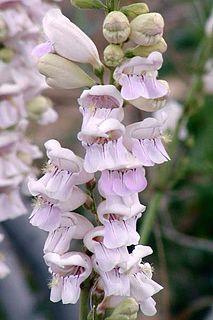
Penstemon, the beardtongues, is a large genus of roughly 250 species of flowering plants native mostly to the Nearctic, but with a few species also found in the North American portion of the Neotropics. It is the largest genus of flowering plants endemic to North America. Formerly placed in the family Scrophulariaceae by the Cronquist system, new genetic research has placed it in the vastly expanded family Plantaginaceae.

Keckiella corymbosa is a species of flowering shrub in the plantain family known by the common names redwood keckiella, red beardtongue, and red shrubby penstemon.

Clarkia mildrediae is an uncommon species of flowering plant in the evening primrose family known by the common name Mildred's clarkia. It is endemic to California, where it is known from the forests of the southernmost Cascade Range and northern Sierra Nevada. It is an erect annual herb often exceeding half a meter in height. The oval leaves grow up to 6 centimeters long and are borne on petioles of up to 4 centimeters. The inflorescence bears opening flowers and hanging, pointed flower buds. As the bud opens the sepals all separate instead of remaining fused as those of many other Clarkia species do. The triangular to semicircular petals are about 2 centimeters long and lavender to bright reddish-purple, sometimes with dark speckling. There are 8 stamens with anthers all alike, and a protruding stigma.
Penstemon calcareus is a species of penstemon known by the common name limestone beardtongue. It is native to California, where it is known from the deserts of central San Bernardino County, as well as the Death Valley area, where its distribution extends just over the border into Nevada. It grows in scrub and woodland, often on limestone substrates. It is a perennial herb with erect branches up to about 25 centimeters in maximum height, grayish with a coating of fine hairs. The toothed, lance-shaped leaves are up to 6 centimeters long. The inflorescence produces bright pink to purplish tubular or funnel-shaped flowers between 1 and 2 centimeters long. The flower has a glandular outer surface and a staminode coated with yellow hairs.

Penstemon fruticiformis is a species of penstemon known by the common name Death Valley beardtongue. It is native to the western United States, where it is found growing in rocky scrub, woodlands, deserts and mountains of eastern California and western Nevada. It is known from scattered occurrences around Death Valley, and only one of the two varieties occurs on the Nevada side of the border. It is a perennial herb producing spreading, multibranched, hairless and waxy stems 30 to 60 centimeters tall. The thick leaves are generally lance-shaped, folded and rolled, and up to 6.5 centimeters in length. The inflorescence produces several white or pale pinkish-lavender flowers between 2 and 3 centimeters long. The mouth of the flower bears a stark, dark line on each of its three lower lobes, nectar guides for its pollinators which probably include native bumble bees.
Penstemon pahutensis is a species of penstemon known by the common name Pahute Mesa beardtongue, or simply Pahute beardtongue. It is native to the desert hills and mountains of southern Nevada, including the Pahute Mesa for which it is named. It can also be found in a few areas over the border in California. It is a perennial herb growing up to 35 centimeters (14 in) tall. The paired, narrow leaves are linear to lance-shaped and up to 10 centimeters (4 in) long. The inflorescence bears blue-purple flowers up to 3 centimeters long. The inside of the wide mouth of the flower is lined with white or yellow hairs, and the staminode is coated in yellow hairs.
Penstemon personatus is an uncommon species of penstemon known by the common name closethroat beardtongue.
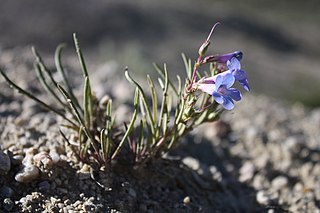
Penstemon penlandii is a rare species of flowering plant in the plantain family known by the common names Penland penstemon and Penland's beardtongue. It is endemic to Colorado in the United States, where it is known only from a strip of land about five miles long in central Grand County. There are two occurrences totalling about 8600 individuals. This is a federally listed endangered species of the United States.

Schoenocrambe argillacea is a rare species of flowering plant in the mustard family known by the common names clay reed-mustard, Uinta Basin plainsmustard, and clay thelypody.
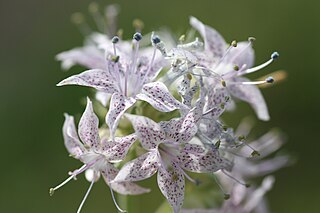
Ipomopsis polyantha is a rare species of flowering plant in the phlox family known by the common names Pagosa ipomopsis, Pagosa skyrocket and Archuleta County standing-cypress. It is endemic to Colorado in the United States, where it occurs only in the vicinity of Pagosa Springs in Archuleta County. It is threatened by the loss of its habitat to residential and commercial development. It was federally listed as an endangered species in 2011.
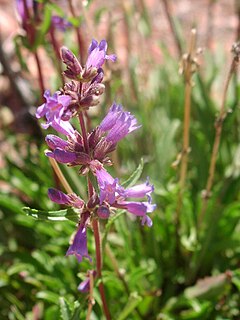
Penstemon pinorum is a rare species of flowering plant in the plantain family known by the common names Pine Valley penstemon and pinyon penstemon. It is endemic to Utah in the United States, where it is known only from an area along the border between Washington and Iron Counties.
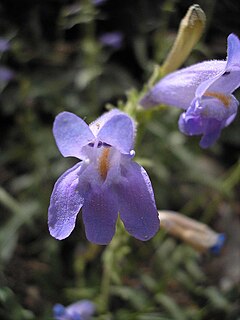
Penstemon pudicus is a rare species of flowering plant in the plantain family known by the common names bashful beardtongue and Kawich Range beardtongue. It is endemic to Nevada in the United States, where it is known only from the Kawich Range in Nye County.

Penstemon degeneri is a species of flowering plant in the plantain family known by the common name Degener's beardtongue. It is endemic to Colorado in the United States, where it occurs in and around the Arkansas River Canyon in Fremont, Custer, and Chaffee Counties.
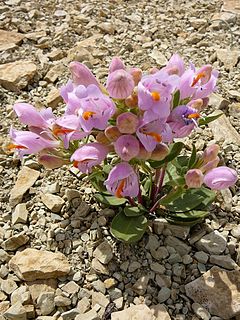
Penstemon grahamii, known by the common names Uinta Basin beardtongue and Graham's beardtongue, is a species of flowering plant in the plantain family. It is native to Utah and Colorado in the United States.

Penstemon scariosus is a species of flowering plant in the plantain family known by the common name White River beardtongue. It is native to Colorado, Utah, and Wyoming in the United States.

Penstemon attenuatus is a species of flowering plant in the plantain family known by the common names sulphur penstemon and taperleaf beardtongue. It is native to the northwestern United States.

Penstemon cyaneus is a species of flowering plant in the plantain family known by the common names blue penstemon and dark-blue beardtongue. It is native to the western United States, where it is widespread in Idaho, Montana, and Wyoming.

Penstemon eriantherus is a species of flowering plant in the plantain family known by the common names fuzzytongue penstemon and crested beardtongue. It is native to western North America, where it occurs in western Canada and the northwestern and north-central United States.
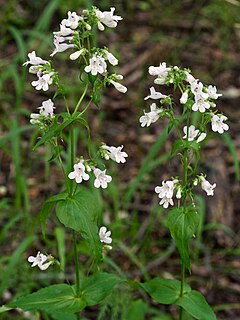
Penstemon tenuis is a species of flowering plant in the plantain family known by the common name sharpsepal beardtongue. It is endemic to Texas, Louisiana, Mississippi, and Arkansas in the United States where it is found in open, damp areas in alluvial soil. It flowers from early April into early June.

Penstemon arkansanus is a species of flowering plant in the plantain family known by the common name Arkansas beardtongue. It is endemic to Texas, Arkansas, Oklahoma, Missouri, and Illinois in the United States, occurring in rocky or sandy soils of shale or sandstone.


















